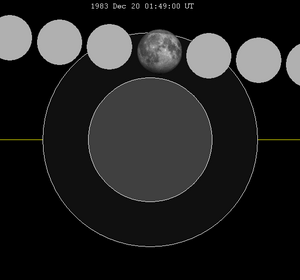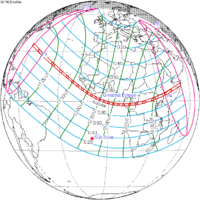|
December 1983 lunar eclipse
A penumbral lunar eclipse occurred at the Moon’s ascending node of orbit on Tuesday, December 20, 1983,[1] with an umbral magnitude of −0.1167. A lunar eclipse occurs when the Moon moves into the Earth's shadow, causing the Moon to be darkened. A penumbral lunar eclipse occurs when part or all of the Moon's near side passes into the Earth's penumbra. Unlike a solar eclipse, which can only be viewed from a relatively small area of the world, a lunar eclipse may be viewed from anywhere on the night side of Earth. Occurring about 2.7 days before perigee (on December 22, 1983, at 18:25 UTC), the Moon's apparent diameter was larger.[2] VisibilityThe eclipse was completely visible over much of North America, South America, Europe, much of Africa, and west and north Asia, seen rising over western North America and the eastern Pacific Ocean and setting over southeast Africa and central and south Asia.[3]
Eclipse detailsShown below is a table displaying details about this particular solar eclipse. It describes various parameters pertaining to this eclipse.[4]
Eclipse seasonThis eclipse is part of an eclipse season, a period, roughly every six months, when eclipses occur. Only two (or occasionally three) eclipse seasons occur each year, and each season lasts about 35 days and repeats just short of six months (173 days) later; thus two full eclipse seasons always occur each year. Either two or three eclipses happen each eclipse season. In the sequence below, each eclipse is separated by a fortnight.
Related eclipsesEclipses in 1983
Metonic
Tzolkinex
Half-Saros
Tritos
Lunar Saros 144
Inex
Triad
Lunar eclipses of 1980–1984This eclipse is a member of a semester series. An eclipse in a semester series of lunar eclipses repeats approximately every 177 days and 4 hours (a semester) at alternating nodes of the Moon's orbit.[5] The penumbral lunar eclipses on March 1, 1980 and August 26, 1980 occur in the previous lunar year eclipse set, and the penumbral lunar eclipses on May 15, 1984 and November 8, 1984 occur in the next lunar year eclipse set.
Saros 144Lunar Saros series 144, repeating every 18 years and 11 days, has a total of 71 lunar eclipse events including 20 total lunar eclipses. First Penumbral Lunar Eclipse: 1749 Jul 29 First Partial Lunar Eclipse: 2146 Mar 28 First Total Lunar Eclipse: 2308 Jul 04 First Central Lunar Eclipse: 2362 Aug 06 Greatest Eclipse of the Lunar Saros 144: 2416 Sep 07 Last Central Lunar Eclipse: 2488 Oct 20 Last Total Lunar Eclipse: 2651 Jan 28 Last Partial Lunar Eclipse: 2867 Jun 08 Last Penumbral Lunar Eclipse: 3011 Sep 04 Half-Saros cycleA lunar eclipse will be preceded and followed by solar eclipses by 9 years and 5.5 days (a half saros).[6] This lunar eclipse is related to two partial solar eclipses of Solar Saros 151.
See alsoNotes
External links
|
|||||||||||||||||||||||||||||||||||||||||||||||||||||||||||||||||||||||||||||||||||||||||||||||||||||||||||||||||||||||||||||
























